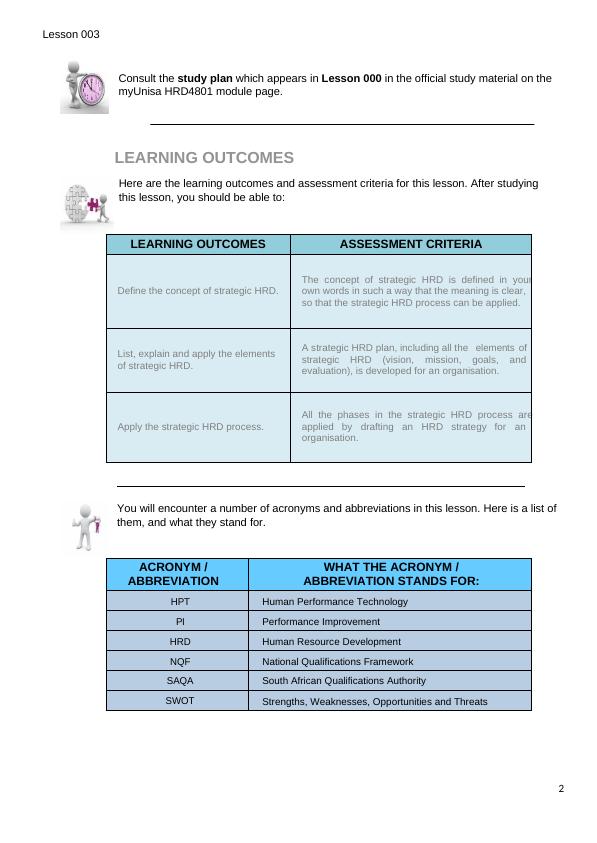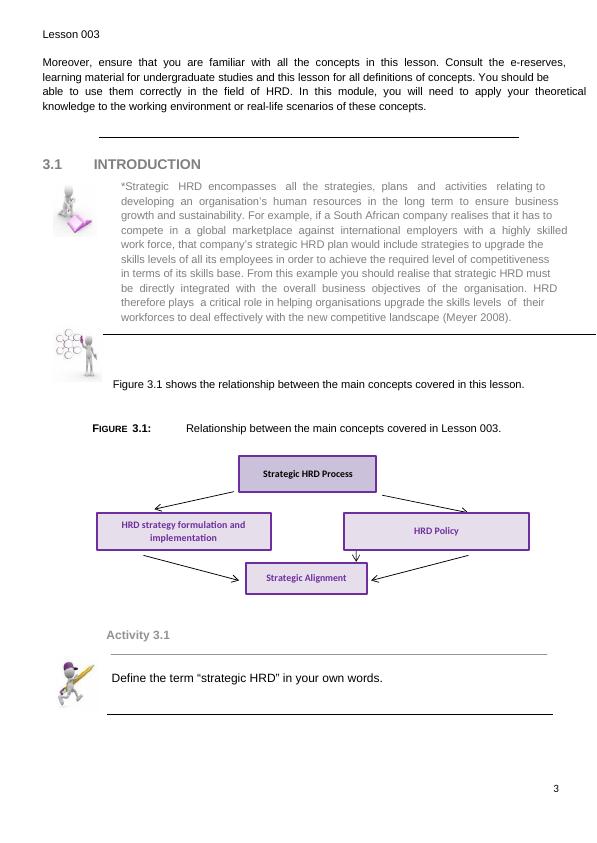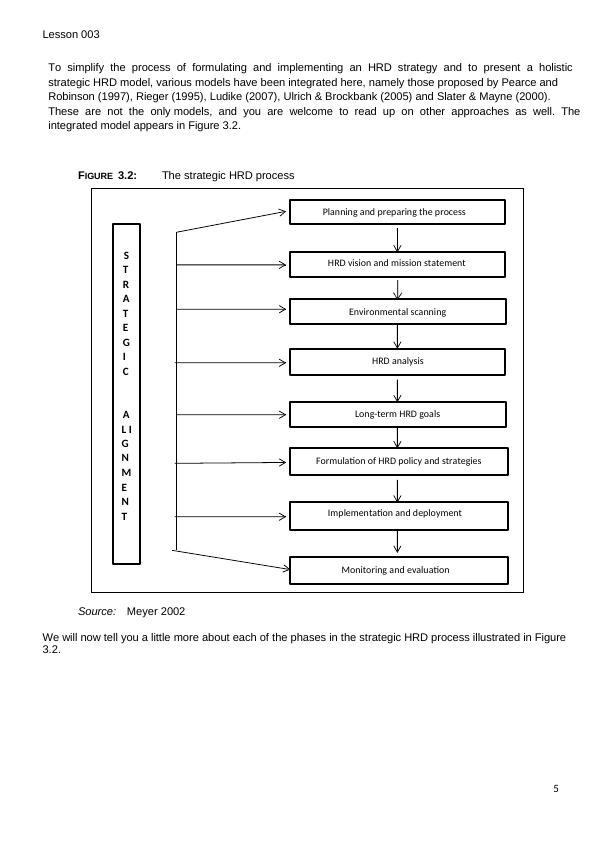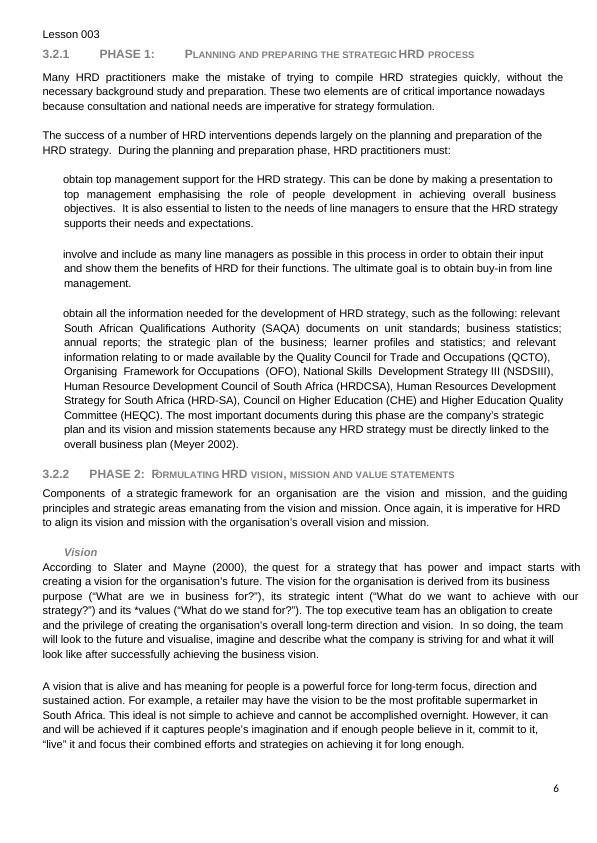Lesson 003 Strategic HRD Process
28 Pages9478 Words184 Views
Added on 2021-07-20
Lesson 003 Strategic HRD Process
Added on 2021-07-20
ShareRelated Documents
Lesson 003
Strategic HRD Process
TABLE OF CONTENTS
ITEM HEADING
3.1 INTRODUCTION
3.2 HRD STRATEGY FORMULATION AND IMPLEMENTATION
3.2.1 Phase 1: Planning and preparing the strategic HRD process
3.2.2 Phase 2: Formulating HRD vision, mission and value statements
3.2.3 Phase 3: Environmental scanning
3.2.4 Phase 4: HRD analysis
3.2.5 Phase 5: Formulating long-term HRD goals and objectives
3.2.6 Phase 6: Formulating HRD policy and strategy
3.2.7 Phase 7: Deployment and implementation
3.2.8 Phase 8: Monitoring and evaluation
3.2.9 Phase 9: Strategic alignment
3.3 CONCLUSION
3.4 SELF-ASSESSMENT QUESTIONS
3.5 SELF-ASSESSMENT CHECKLIST
3.6 SUGGESTED READING
3.7 REFERENCES
3.8 INTERNET RESOURCES/WEBSITES YOU MAY WANT TO CONSULT
3.9 E-RESERVES
Open Rubric

Lesson 003
2
Consult the study plan which appears in Lesson 000 in the official study material on the
myUnisa HRD4801 module page.
LEARNING OUTCOMES
Here are the learning outcomes and assessment criteria for this lesson. After studying
this lesson, you should be able to:
LEARNING OUTCOMES ASSESSMENT CRITERIA
Define the concept of strategic HRD.
The concept of strategic HRD is defined in your
own words in such a way that the meaning is clear,
so that the strategic HRD process can be applied.
List, explain and apply the elements
of strategic HRD.
A strategic HRD plan, including all the elements of
strategic HRD (vision, mission, goals, and
evaluation), is developed for an organisation.
Apply the strategic HRD process.
All the phases in the strategic HRD process are
applied by drafting an HRD strategy for an
organisation.
You will encounter a number of acronyms and abbreviations in this lesson. Here is a list of
them, and what they stand for.
ACRONYM /
ABBREVIATION
WHAT THE ACRONYM /
ABBREVIATION STANDS FOR:
HPT
Human Performance Technology
PI
Performance Improvement
HRD
Human Resource Development
NQF
National Qualifications Framework
SAQA
South African Qualifications Authority
SWOT
Strengths, Weaknesses, Opportunities and Threats
2
Consult the study plan which appears in Lesson 000 in the official study material on the
myUnisa HRD4801 module page.
LEARNING OUTCOMES
Here are the learning outcomes and assessment criteria for this lesson. After studying
this lesson, you should be able to:
LEARNING OUTCOMES ASSESSMENT CRITERIA
Define the concept of strategic HRD.
The concept of strategic HRD is defined in your
own words in such a way that the meaning is clear,
so that the strategic HRD process can be applied.
List, explain and apply the elements
of strategic HRD.
A strategic HRD plan, including all the elements of
strategic HRD (vision, mission, goals, and
evaluation), is developed for an organisation.
Apply the strategic HRD process.
All the phases in the strategic HRD process are
applied by drafting an HRD strategy for an
organisation.
You will encounter a number of acronyms and abbreviations in this lesson. Here is a list of
them, and what they stand for.
ACRONYM /
ABBREVIATION
WHAT THE ACRONYM /
ABBREVIATION STANDS FOR:
HPT
Human Performance Technology
PI
Performance Improvement
HRD
Human Resource Development
NQF
National Qualifications Framework
SAQA
South African Qualifications Authority
SWOT
Strengths, Weaknesses, Opportunities and Threats

Lesson 003
3
Moreover, ensure that you are familiar with all the concepts in this lesson. Consult the e-reserves,
learning material for undergraduate studies and this lesson for all definitions of concepts. You should be
able to use them correctly in the field of HRD. In this module, you will need to apply your theoretical
knowledge to the working environment or real-life scenarios of these concepts.
3.1 INTRODUCTION
*Strategic HRD encompasses all the strategies, plans and activities relating to
developing an organisation’s human resources in the long term to ensure business
growth and sustainability. For example, if a South African company realises that it has to
compete in a global marketplace against international employers with a highly skilled
work force, that company’s strategic HRD plan would include strategies to upgrade the
skills levels of all its employees in order to achieve the required level of competitiveness
in terms of its skills base. From this example you should realise that strategic HRD must
be directly integrated with the overall business objectives of the organisation. HRD
therefore plays a critical role in helping organisations upgrade the skills levels of their
workforces to deal effectively with the new competitive landscape (Meyer 2008).
Figure 3.1 shows the relationship between the main concepts covered in this lesson.
FIGURE 3.1: Relationship between the main concepts covered in Lesson 003.
Strategic HRD Process
HRD strategy formulation and
implementation
HRD Policy
Strategic Alignment
Activity 3.1
Define the term “strategic HRD” in your own words.
3
Moreover, ensure that you are familiar with all the concepts in this lesson. Consult the e-reserves,
learning material for undergraduate studies and this lesson for all definitions of concepts. You should be
able to use them correctly in the field of HRD. In this module, you will need to apply your theoretical
knowledge to the working environment or real-life scenarios of these concepts.
3.1 INTRODUCTION
*Strategic HRD encompasses all the strategies, plans and activities relating to
developing an organisation’s human resources in the long term to ensure business
growth and sustainability. For example, if a South African company realises that it has to
compete in a global marketplace against international employers with a highly skilled
work force, that company’s strategic HRD plan would include strategies to upgrade the
skills levels of all its employees in order to achieve the required level of competitiveness
in terms of its skills base. From this example you should realise that strategic HRD must
be directly integrated with the overall business objectives of the organisation. HRD
therefore plays a critical role in helping organisations upgrade the skills levels of their
workforces to deal effectively with the new competitive landscape (Meyer 2008).
Figure 3.1 shows the relationship between the main concepts covered in this lesson.
FIGURE 3.1: Relationship between the main concepts covered in Lesson 003.
Strategic HRD Process
HRD strategy formulation and
implementation
HRD Policy
Strategic Alignment
Activity 3.1
Define the term “strategic HRD” in your own words.

Lesson 003
4
Feedback
Strategic HRD concerns the long-term development of a company’s employees. The
challenge is to identify the overall business strategy of the company and then to
formulate an HRD strategy that will help it to meet these business objectives.
3.2 HRD STRATEGY FORMULATION AND IMPLEMENTATION
To supplement the information in this section, please do some additional reading of your
own – this could take the form of internet sources, journal articles and books. You may find
some helpful additional sources in Section 3.6.
Strategic management relates to the long-term management of an organisation. The HRD strategy
formulation phase is part of the process of developing an HRD strategy. As a senior HRD manager or
consultant, you will often be required to compile HRD strategy for your organisation or your clients.
HRD strategy formulation should include the following elements (Meyer 2008):
a strategic analysis of the current state of the organisation – in other words, identification of the
strengths and weaknesses of the organisation and HRD
the factors influencing the future of the company, such as new markets and legislation
the integration of the overall strategic plan and HRD strategy
the conversion of the strategic plan into specific HRD activities
a measurement system to monitor the success of the HRD strategy
As part of the strategy formulation, the HRD function has to play a fundamental role in initiating, effecting,
supporting and implementing the strategic plan of the company. It does this by:
creating an enabling environment for HRD (people development as part of line management
responsibility)
aligning the development of the people in the business with the chosen strategies (e.g. workplace
skills plan and performance management systems)
creating systems in which HRD can take place (e.g. leadership development centres, electronic
learning and HRD structures)
building capacity throughout the organisation to effect the changes or strategies (e.g. HRD practitioner
development and assisting line management with on-the-job training programmes)
ensuring that HRD is well governed in the organisation (Meyer 2008).
Many trainers or facilitators are so focused on the technical, functional or skills training they provide that
they forget about the broader picture of HRD in the overall business strategy. Moreover, these trainers
have a short-term perspective on training and skills development.
A structured approach to strategic HRD is necessary to ensure that the appropriate HRD strategies and
plans are put in place to create an effective learning system.
4
Feedback
Strategic HRD concerns the long-term development of a company’s employees. The
challenge is to identify the overall business strategy of the company and then to
formulate an HRD strategy that will help it to meet these business objectives.
3.2 HRD STRATEGY FORMULATION AND IMPLEMENTATION
To supplement the information in this section, please do some additional reading of your
own – this could take the form of internet sources, journal articles and books. You may find
some helpful additional sources in Section 3.6.
Strategic management relates to the long-term management of an organisation. The HRD strategy
formulation phase is part of the process of developing an HRD strategy. As a senior HRD manager or
consultant, you will often be required to compile HRD strategy for your organisation or your clients.
HRD strategy formulation should include the following elements (Meyer 2008):
a strategic analysis of the current state of the organisation – in other words, identification of the
strengths and weaknesses of the organisation and HRD
the factors influencing the future of the company, such as new markets and legislation
the integration of the overall strategic plan and HRD strategy
the conversion of the strategic plan into specific HRD activities
a measurement system to monitor the success of the HRD strategy
As part of the strategy formulation, the HRD function has to play a fundamental role in initiating, effecting,
supporting and implementing the strategic plan of the company. It does this by:
creating an enabling environment for HRD (people development as part of line management
responsibility)
aligning the development of the people in the business with the chosen strategies (e.g. workplace
skills plan and performance management systems)
creating systems in which HRD can take place (e.g. leadership development centres, electronic
learning and HRD structures)
building capacity throughout the organisation to effect the changes or strategies (e.g. HRD practitioner
development and assisting line management with on-the-job training programmes)
ensuring that HRD is well governed in the organisation (Meyer 2008).
Many trainers or facilitators are so focused on the technical, functional or skills training they provide that
they forget about the broader picture of HRD in the overall business strategy. Moreover, these trainers
have a short-term perspective on training and skills development.
A structured approach to strategic HRD is necessary to ensure that the appropriate HRD strategies and
plans are put in place to create an effective learning system.

Lesson 003
5
To simplify the process of formulating and implementing an HRD strategy and to present a holistic
strategic HRD model, various models have been integrated here, namely those proposed by Pearce and
Robinson (1997), Rieger (1995), Ludike (2007), Ulrich & Brockbank (2005) and Slater & Mayne (2000).
These are not the only models, and you are welcome to read up on other approaches as well. The
integrated model appears in Figure 3.2.
FIGURE 3.2: The strategic HRD process
Planning and preparing the process
S
T HRD vision and mission statement
R
A
T Environmental scanning
E
G
I HRD analysis
C
A Long-term HRD goals
L I
G
N Formulation of HRD policy and strategies
M
E
N
T Implementation and deployment
Monitoring and evaluation
Source: Meyer 2002
We will now tell you a little more about each of the phases in the strategic HRD process illustrated in Figure
3.2.
5
To simplify the process of formulating and implementing an HRD strategy and to present a holistic
strategic HRD model, various models have been integrated here, namely those proposed by Pearce and
Robinson (1997), Rieger (1995), Ludike (2007), Ulrich & Brockbank (2005) and Slater & Mayne (2000).
These are not the only models, and you are welcome to read up on other approaches as well. The
integrated model appears in Figure 3.2.
FIGURE 3.2: The strategic HRD process
Planning and preparing the process
S
T HRD vision and mission statement
R
A
T Environmental scanning
E
G
I HRD analysis
C
A Long-term HRD goals
L I
G
N Formulation of HRD policy and strategies
M
E
N
T Implementation and deployment
Monitoring and evaluation
Source: Meyer 2002
We will now tell you a little more about each of the phases in the strategic HRD process illustrated in Figure
3.2.

Lesson 003
6
3.2.1 PHASE 1: PLANNING AND PREPARING THE STRATEGIC HRD PROCESS
Many HRD practitioners make the mistake of trying to compile HRD strategies quickly, without the
necessary background study and preparation. These two elements are of critical importance nowadays
because consultation and national needs are imperative for strategy formulation.
The success of a number of HRD interventions depends largely on the planning and preparation of the
HRD strategy. During the planning and preparation phase, HRD practitioners must:
obtain top management support for the HRD strategy. This can be done by making a presentation to
top management emphasising the role of people development in achieving overall business
objectives. It is also essential to listen to the needs of line managers to ensure that the HRD strategy
supports their needs and expectations.
involve and include as many line managers as possible in this process in order to obtain their input
and show them the benefits of HRD for their functions. The ultimate goal is to obtain buy-in from line
management.
obtain all the information needed for the development of HRD strategy, such as the following: relevant
South African Qualifications Authority (SAQA) documents on unit standards; business statistics;
annual reports; the strategic plan of the business; learner profiles and statistics; and relevant
information relating to or made available by the Quality Council for Trade and Occupations (QCTO),
Organising Framework for Occupations (OFO), National Skills Development Strategy III (NSDSIII),
Human Resource Development Council of South Africa (HRDCSA), Human Resources Development
Strategy for South Africa (HRD-SA), Council on Higher Education (CHE) and Higher Education Quality
Committee (HEQC). The most important documents during this phase are the company’s strategic
plan and its vision and mission statements because any HRD strategy must be directly linked to the
overall business plan (Meyer 2002).
3.2.2 PHASE 2: FORMULATING HRD VISION, MISSION AND VALUE STATEMENTS
Components of a strategic framework for an organisation are the vision and mission, and the guiding
principles and strategic areas emanating from the vision and mission. Once again, it is imperative for HRD
to align its vision and mission with the organisation’s overall vision and mission.
Vision
According to Slater and Mayne (2000), the quest for a strategy that has power and impact starts with
creating a vision for the organisation’s future. The vision for the organisation is derived from its business
purpose (“What are we in business for?”), its strategic intent (“What do we want to achieve with our
strategy?”) and its *values (“What do we stand for?”). The top executive team has an obligation to create
and the privilege of creating the organisation’s overall long-term direction and vision. In so doing, the team
will look to the future and visualise, imagine and describe what the company is striving for and what it will
look like after successfully achieving the business vision.
A vision that is alive and has meaning for people is a powerful force for long-term focus, direction and
sustained action. For example, a retailer may have the vision to be the most profitable supermarket in
South Africa. This ideal is not simple to achieve and cannot be accomplished overnight. However, it can
and will be achieved if it captures people’s imagination and if enough people believe in it, commit to it,
“live” it and focus their combined efforts and strategies on achieving it for long enough.
6
3.2.1 PHASE 1: PLANNING AND PREPARING THE STRATEGIC HRD PROCESS
Many HRD practitioners make the mistake of trying to compile HRD strategies quickly, without the
necessary background study and preparation. These two elements are of critical importance nowadays
because consultation and national needs are imperative for strategy formulation.
The success of a number of HRD interventions depends largely on the planning and preparation of the
HRD strategy. During the planning and preparation phase, HRD practitioners must:
obtain top management support for the HRD strategy. This can be done by making a presentation to
top management emphasising the role of people development in achieving overall business
objectives. It is also essential to listen to the needs of line managers to ensure that the HRD strategy
supports their needs and expectations.
involve and include as many line managers as possible in this process in order to obtain their input
and show them the benefits of HRD for their functions. The ultimate goal is to obtain buy-in from line
management.
obtain all the information needed for the development of HRD strategy, such as the following: relevant
South African Qualifications Authority (SAQA) documents on unit standards; business statistics;
annual reports; the strategic plan of the business; learner profiles and statistics; and relevant
information relating to or made available by the Quality Council for Trade and Occupations (QCTO),
Organising Framework for Occupations (OFO), National Skills Development Strategy III (NSDSIII),
Human Resource Development Council of South Africa (HRDCSA), Human Resources Development
Strategy for South Africa (HRD-SA), Council on Higher Education (CHE) and Higher Education Quality
Committee (HEQC). The most important documents during this phase are the company’s strategic
plan and its vision and mission statements because any HRD strategy must be directly linked to the
overall business plan (Meyer 2002).
3.2.2 PHASE 2: FORMULATING HRD VISION, MISSION AND VALUE STATEMENTS
Components of a strategic framework for an organisation are the vision and mission, and the guiding
principles and strategic areas emanating from the vision and mission. Once again, it is imperative for HRD
to align its vision and mission with the organisation’s overall vision and mission.
Vision
According to Slater and Mayne (2000), the quest for a strategy that has power and impact starts with
creating a vision for the organisation’s future. The vision for the organisation is derived from its business
purpose (“What are we in business for?”), its strategic intent (“What do we want to achieve with our
strategy?”) and its *values (“What do we stand for?”). The top executive team has an obligation to create
and the privilege of creating the organisation’s overall long-term direction and vision. In so doing, the team
will look to the future and visualise, imagine and describe what the company is striving for and what it will
look like after successfully achieving the business vision.
A vision that is alive and has meaning for people is a powerful force for long-term focus, direction and
sustained action. For example, a retailer may have the vision to be the most profitable supermarket in
South Africa. This ideal is not simple to achieve and cannot be accomplished overnight. However, it can
and will be achieved if it captures people’s imagination and if enough people believe in it, commit to it,
“live” it and focus their combined efforts and strategies on achieving it for long enough.

End of preview
Want to access all the pages? Upload your documents or become a member.
Related Documents
Developing workplace communication strategies Participant Workbook CHCCOM003 PW Moodle CHC51015 V1.0 CHCCOM003 Develop workplace communication strategies Participant Workbook CHCCOM003 PW Moodle CHC51lg...
|76
|11192
|92
Manage Performance Management Assignmentlg...
|48
|10005
|201
Assessment Criteria for BSBHRM512lg...
|21
|4372
|1
Develop and Manage Performance Management Processes Learnerlg...
|58
|13212
|11
